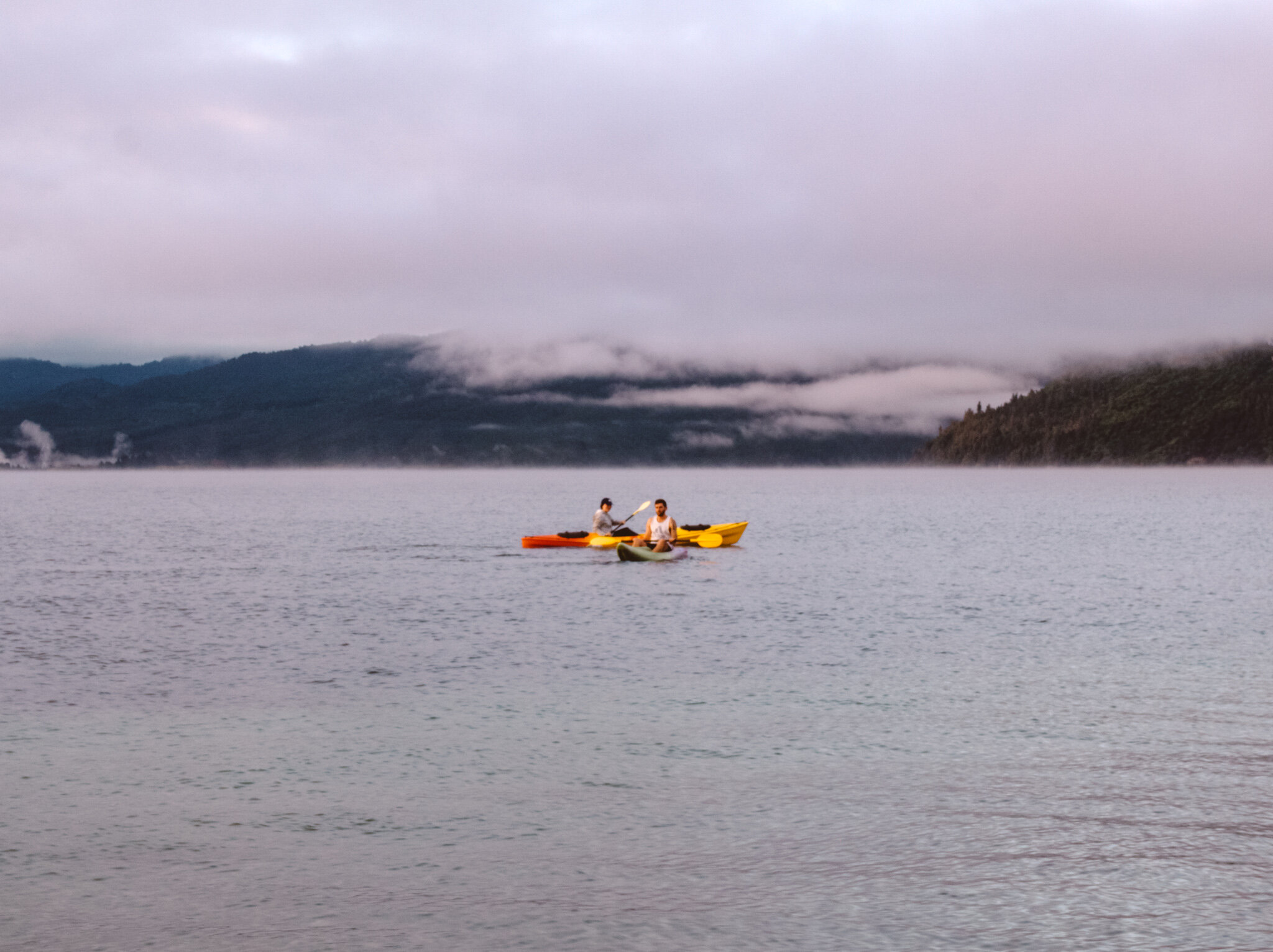how to kayak for beginners: a complete guide with what you need to know
Interested in kayaking but not sure where to start? This guide provides helpful tips and advice for beginners, from choosing the right equipment to mastering basic techniques and staying safe on the water.
I can’t understate the importance of getting outside for your physical and mental health. Activities like hiking, foraging, and kayaking are easy to do while maintaining physical distancing restrictions. They’re also some of my favourite past times and they’re easy to get stuck into.
On an impromptu trip to the U.S., I took a course with the Department of Natural Resources in Bloomington, Indiana, for beginner kayaking. No, it hadn’t been my first time kayaking, but my family wanted to take advantage of their close proximity to lakes and “get into” paddling the water. So we took the USD $10 for some quality time and further instruction on water safety, what gear to have, and what to know before you start.
As a full-time traveler {although, what does that even really mean??}, having my international travel plans postponed, travel work gigs cancelled, and acknowledging that going anywhere with a struggling healthcare infrastructure {which is pretty much everywhere during a pandemic} would be incredibly irresponsible given the current climate has been r o u g h. I’ve been chomping at the bit to get back out into the world but, until my postponed explorations can commence {fingers crossed for autumn in Nepal}, I’m taking full advantage of all the goodness that Mother Nature has to offer. This includes using my time to dive deeper into outdoor recreational activities I have dabbled in or previously enjoyed but haven’t ever fully researched or studied.
the basics of kayaking ↴
There are a variety of different kinds of kayaking for people to participate in: sea kayaking, flatwater kayaking, whitewater kayaking, etc.
Here are some basic questions to ask yourself before you set out on the water:
Where will you be kayaking? In a lake? In a river? In the ocean?
Where will you get a kayak from? Do you know a company close to you that hires? Are you borrowing equipment from a friend?
Does your rental come with floatation aids like life jackets?
Once you have a kayak “game plan” set and ready, you’ll need to familiarize yourself with these few bits and pieces of information:
the correct way to get into your kayak
There are a few ways to initially get into your kayak. Most kayaking pros hop in without thinking, but first-timers should pause and learn th simple “three-point technique”. What three-point refers to is the three points of contact with your kayak. This usually means two hands and a leg. It’s another way of saying “don’t try to jump into a kayak with one hand holding the boat and all your body weight on one side and expect to get in smoothly”. This goes for getting out of your kayak too. I’ve found a helpful video to demonstrate what I am attempting to articulate {see right}.
how to sit properly in your kayak
“You just sit down, right?” Well, essentially, yeah. But there are some minute details that will make your time on the water more comfortable. The first is making sure your legs are in the correct position. You want them slightly bent but not so much so that you feel cramped or that your paddle hits your knee once you get going. Many kayaks have pegs for your feet that are adjustable, but you will have to check the model of your boat and get to know it so that you can make it your own. Point your toes outward and your heels inward. Make sure not to slouch— if you are out for a few hours and you’re hunched over, your spine and abs are going to feel yuck by the end of the journey. Posture is key and will help you develop core strength.
holding the paddle the right way
This might sound obvious but plenty of people hold their paddle the wrong way when learning to kayak. Hold the paddle with both hands just over shoulder distance apart. Make sure the concave part of the blade is facing you. When you dip the paddle blade into the water, the concave part should sweep through the water. Check your knuckles are in line with the blade.
where to get your gear on a budget + what you need ↴
I have found that gear makes people freak out the most with just about every hobby. When you tell people the amount of camera, travel, or hiking kit to have, they almost always start calculating a total price tag in their heads and bail. Don’t! Kayaking can actually be a very affordable outdoor recreation activity.
Some ways to cut costs on kayaking gear include:
renting your kayak, paddle, and PFD from a local company or from an instructor {if you pay for classes, they almost always supply the gear you need}
borrowing your kayak, paddle, and PFD from a friend
buy one thing at a time until you slowly have everything you need {there’s no rush in buying every single thing all at once}
S e c o n d h a n d is your f r i e n d!! Guys, buying gear secondhand is a win-freakin-win! Your bank account isn’t in as much pain and the environment is like “YAS ECO-QUEEN, USE ME!”
So, other than the obvious {a kayak, a PFD, and a paddle}, what gear do you need? Not much…Bring water, snacks, and a dry bag {for your personal items that you don’t want to risk getting soggy}. Additionally, a signalling whistle is a great piece of safety equipment to have on hand in case you get in a pinch.
what to wear kayaking ↴
It might seem like you can just jump into your kayak and paddle off into the sunset with whatever you have on. Unfortunately, that’s not the case if you want to be safe, dry, and protected from the sun.
To make it easy, I have put together a list of tips for kitting yourself up:
Avoid cotton at all cost. Cotton absorbs water and stays wet for a l o n g time. Opt for a quick-drying fabric instead, like a nylon or polyester. For a more environmentally positive choice, go for wool!
A l w a y s wear a personal floatation device {otherwise known as a floatation aid or PFD}. You shouldn’t ever take it off while you are on the water. Experts suggest that if you need to take off an outer layer, you should park up your kayak before you take off your PFD. I’m just going to say it: I hardly ever wear a life jacket when I go floating, canoeing, or kayaking…which is incredibly stupid and lazy. Only when I’ve been in rapids or when it’s been mandated have I followed this rule. I definitely need to do much better, and this isn’t a point of pride. Let’s all be smarter and safer and wear our PFDs, k?
Dress in layers, especially on your top half, so that you can strip down in the heat, cover up in the sun, and stay warm in the breeze.
Wear sunscreen even if you are wearing a hat or rashguard. UV rays can penetrate fabrics, so it’s a good precaution to take to lather up before you layer up. Even on days with heavy cloud-cover, being on the water leads to lots of sun exposure., since the water reflects light from the bottom upward.
Avoid rust-prone hardware and fasteners on jackets, shoes, etc. I wore a pair of Birkenstocks to the beach on time in New Zealand and the buckles are all rusty now…but, like…I love them still. I just wish I had used my brain. So, learn from my mistake and make sure any zippers or hardware on your kit is rust-proof.
kayak safety tips ↴
take a course first
As simple as kayaking is and seems {sit in boat, use oar to row}, it is helpful to take a beginner’s kayaking course first. I had been kayaking many, many times over the years. I only took a course this summer through the Indiana Department of Natural Resources, because my parents wanted to complete it as a family activity. After the two hours were up, I was kind of sad I hadn’t taken
dress for the water, not for the weather
Even if the sun is shining and it’s a warm summer day, the water temperature might be ice cold. If you are dressed for the weather and not the water, in the unlikely event that you tip over your kayak, you’ll regret not being prepared. Kayaking alone and being ill-prepared for cold water brings the additional risk of hypothermia with it. Be safe and dress like you know you’re taking a plunge. Also, avoid cotton at all costs!
wear a floatation device
In many places this is actually a water rule, but even in the places where it’s not law you should be wearing some kind of floatation device. You should, ultimately, wear this kind of aid despite your experience level {a rule I should follow more often myself…}. This could be a traditional life jacket or a waist buoyancy belt. Even if you are a strong swimmer, you never know when you might get into trouble in the water. Life jackets are almost always provided by kayaking schools or watersport rental companies.
bring a change of clothes
You might be thinking, “Umm…why is this a safety tip? I’m confused…” Here’s the thing: if you fall into the water and you get cold and you have no towel or change of clothes waiting for you in your vehicle, your risk of hypothermia skyrockets. No one wants to sit in their wet, soggy clothes on the ride home after an epic kayak anyway. Bring a change of clothes to be safe and give you a dry option if youThis is another simple piece of advice but easy to forget. Always bring a change of clothes, even if you don’t think you are going to get wet. I can’t emphasise the number of times I’ve been grateful for that spare set of clothes.
know how to conduct a water rescue
It is entirely possible to go kayaking and not get wet. But, on the odd occasion you capsize, your boat isn’t going to be any good to you if you can’t get back in it while you are in the middle of a lake or other body of water. Stay with your boat if you capsize {kayaks float…obvious, right?}. This is another reason why an instruction course or water guide is useful— they almost always cover how to get back into your boat or how to help your fellow kayakers out if they get into a jam.
people > kayaks
This sounds obvious, but since I wrote in the previous paragraph “stay with your boat if you capsize”, I thought I should probably throw in the caveat that if you are in a drastic, dangerous situation…leave your damn boat. Kayaks can be replaced. People, however, cannot.
don’t kayak alone
Tempting as it is, especially right now when the world feels loud and heavy at times and you just want to shut it all out, it’s important to make sure you have a kayaking partner. If something were to happen to you out on the water while you are alone, you' have only yourself to depend on. If you get into trouble while out, this partner-system insures you have someone to go get help if they can’t be of assistance to you themselves.



























